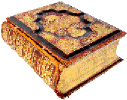Among the numerous symbols of solar worship, besides those we have already referred to, there are three to which we will direct attention. Two of these were of astronomical signification: the one adopted when the Spring Equinox was in the sign of Taurus and shaped like the letter T, was the model after which the ancient temples were built; and the other, shaped like the letter X, in reference to the angle of 23 1/2 degrees made by the crossing of the Ecliptic and the Celestial equator, is known as St. Andrew’s Cross. The third, and most important of all the symbols of solar worship, in its relation to the Christian religion, which, having no astronomical signification, originated in Egypt, in reference to the annual inundation of the river Nile. To mark the height to which the water should rise to secure an abundant harvest, posts were planted upon its banks to which cross beams were attached thus +. If the water should rise to the designated height, it was called “the waters of life,” or “river of life;” and, ultimately, this form of the cross was adopted as the symbol of the life to come, or eternal life; and the ancient astrologers had it engraved upon stone, encircled with a hieroglyphical inscription to that effect, one of which was discovered in the ruins of the temple erected at Alexandria, and dedicated to “our Lord and Saviour Serapis.”
But, if the water failed to rise to the required height, and the horrors of starvation becoming the inevitable result, it was the custom of the people to nail to these crosses symbolical personifications of the Demon of Famine. To indicate the sterility of the domain over which he reigned, he was represented by the figure of a lean and haggard man, with a crown of thorns upon his head; a reed cut from the river’s bank was placed in his hands, as his unreal sceptre; and, considering the inhabitants of Judea as the most slavish and mean-spirited race in their knowledge, they placarded this figure with the inscription: “This is the King of the Jews.” Thus, to the ancient Egyptians, this sign of the cross was blessed or accursed as it was represented with, or without, this figure suspended upon it.
When the Roman, or modern, form of Christianity was instituted, the hieroglyphical inscription signifying the life to come or eternal life was substituted by a placard nailed to the cross with the letters I. N. R. I. inscribed upon it, which are the initials of the Latin words conveying the same meaning. But if we would learn how the figure of a man came to be suspended upon this form of the cross, we must refer to Mediaeval History, which teaches that in the year 680, under the Pontificate of Agathon, and during the reign of Constantine Pogonat, at the sixth council of the church, and third at Constantinople, it was ordered in Canon 82 that “Instead of a lamb, the figure of a man nailed to a cross should be the distinguishing symbol of the Christian religion.” Now, as this figure is represented by that of a lean and haggard man, with a crown of thorns upon his head, does it not look as if the old Egyptian Demon of Famine was the model after which it was constructed?
 AstroLibrary 🔎
AstroLibrary 🔎